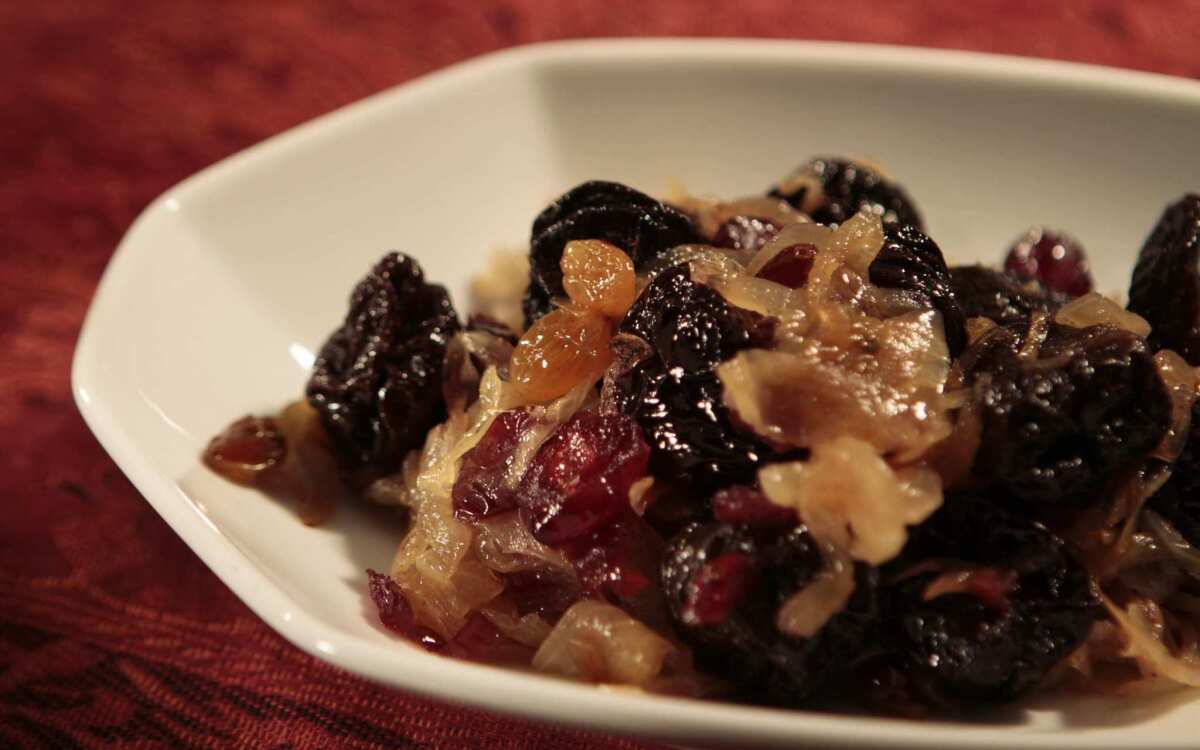Dried fruit and almond garnish

It seems like Rosh Hashanah customs were created by lovers of fruits and vegetables. Most families will begin Sunday night’s holiday dinner with apple wedges dipped in honey to symbolize the hope for a sweet new year, and many serve sweet vegetables, especially carrots and sweet potatoes.
We like the Sephardi custom of starting the meal with a mini-Seder, a ritual derived from the Talmud. Guests sample small portions of certain vegetables and fruits, such as pumpkin, leeks, chard, black-eyed peas, pomegranate seeds and dates, and say a blessing with each one. The choices vary depending on what’s available at the market -- pumpkin might be replaced by other squashes, black-eyed peas by other beans, and chard by beet leaves or spinach.
And the blessings vary depending on the community and individual home. Some blessings have roots in Talmudic symbolism. Pomegranate seeds are served because they stand for the wish that one’s mitzvot, or good deeds, be as numerous as the fruit’s seeds, which are said to be 613, the same as the number of commandments in the Torah.
Other blessings are actually puns on the Hebrew or Aramaic names of the foods. The word for black-eyed peas, for example, sounds like the word for increase, and therefore the blessing is “may our merits increase.”
To make the blessings more meaningful, some create puns based on the language spoken in their home. Suggestions for English speakers include eating peas as a hope for peace. Some of these have quite different meanings than in other languages. When eating dates, the traditional saying “may our enemies be destroyed,” based on the Hebrew word for date, could be replaced by wishing single friends “happy dating.”
Because of the emphasis on sweetness for Rosh Hashanah, some avoid lemon juice and other sour ingredients and sharp foods like chiles. There are those who don’t even eat nuts because the Hebrew words for “nut” and for “sin” have the same numerological value.
One of our favorite Jewish New Year customs, observed on the second day of the holiday, calls for eating an exotic fruit or one that has just come into season and reciting a blessing that expresses gratitude for having lived to this joyous day. We enjoy sampling several fruits, such as fresh yellow dates that have turned honey-brown, Asian pears, Keitt mangoes, dragonfruit, lychees or even durian. But the fruits over which we recite this blessing most enthusiastically are fresh figs, preferably from our garden.
To blanch almonds, add them to a pan of boiling water to cover and boil for 10 seconds. Transfer the almonds to a bowl with a slotted spoon, reserving hot water. When they almonds are just cool enough to handle, press the end of each almond to remove it from its skin; return any stubborn ones to the hot water for another 10 seconds, remove and peel. Dry the peeled almonds thoroughly on paper towels before sautéing.
Heat the vegetable oil in a sauté pan or skillet over medium heat. Add the almonds and sauté, tossing often with a slotted spatula, until lightly browned, about 5 minutes. Transfer the almonds to paper towels and sprinkle them lightly with one-eighth teaspoon salt, or to taste.
Heat the olive oil in the sauté pan over medium heat, add the onions and a pinch of salt and cook for 10 minutes. Cover and cook, stirring often, until tender and golden brown, about 15 minutes.
Add the raisins, dried cranberries, sugar and cinnamon. Cover and cook over low heat until the dried fruit is softened, about 5 minutes. Transfer the mixture to a shallow serving bowl.
Add the prunes and broth to pan. Cover and cook over low heat until the prunes are tender, about 5 minutes. Add the prunes and any liquid remaining in the pan to the bowl of dried fruit.
Serve the dried fruit with the almonds.
Get our Cooking newsletter.
Your roundup of inspiring recipes and kitchen tricks.
You may occasionally receive promotional content from the Los Angeles Times.















